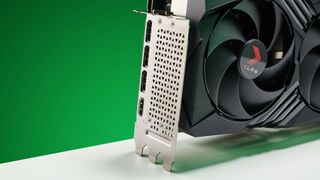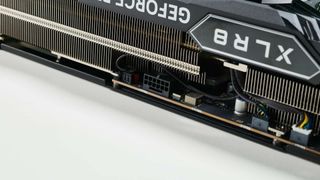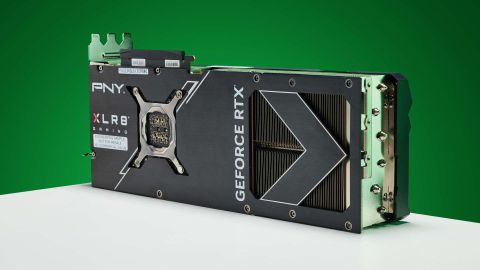Our Verdict
The RTX 4080 is probably the best graphics card you shouldn't be spending your money on. But if you were, then PNY's XLR8 Verto is an MSRP version that delivers all the performance and efficiency of the Ada architecture without the extra fiscal demands of a needless factory overclocked card.
For
- Great RTX 4080 performance
- Frame generation is magic
- Cool and efficient
Against
- Even at MSRP it's overpriced
- HUUUUUUUGE
PC Gamer's got your back
Even by the portly standards of Nvidia's RTX 4080 Founders Edition, the PNY RTX 4080 XLR8 is a damned unit. He chomnk. He's also a supremely powerful graphics card capable of regularly outpacing the best of both Nvidia's last generation of GPUs, the RTX 3090 Ti, as well as AMD's latest RDNA 3 flagship chiplet card, the Radeon RX 7900 XTX.
But seriously guys, $1,200? The current sky-high pricing of modern graphics cards has become endlessly fatiguing. No longer is it just the scalpers, scarcity, and crypto miners driving up pricing, it's being driven directly by the manufacturers themselves.
I'm not laying the blame for that at PNY's door, however, it all stems from the MSRP Nvidia has slapped on the RTX 4080 from the outset. Thankfully this RTX 4080 XLR8 Verto card is at least sticking around at that original retail price and hasn't spiked.
Though it is worth noting were there serious demand for the RTX 4080, and every card was being sold the moment it hit the shelves, then you can bet retailers would be slapping higher sticker prices on them. Just take a look at the nominally competing RX 7900 XTX from AMD. That's a card with a $999 MSRP and yet there's no hope of finding one at that price right now—$1,300 is the cheapest I've found the top Radeon card going for.

GPU: Nvidia AD103
CUDA cores: 9,728
Lithography: TSMC 4N
Boost clock: 2,505MHz
Memory: 16GB GDDR6X
Memory speed: 22.4 Gbps
TGP: 320W
Price: $1,199
And the real-world pricing of the latest AMD card is supremely relevant when we're talking about the RTX 4080 in any guise. The RX 7900 XTX was meant to be AMD's riposte to Nvidia's second-tier GPU, with Dr. Su's gang knowing the RTX 4090 was out of its reach. And yet our testing finds the RTX 4080 and RX 7900 XTX trading blows, and the former coming with the might of DLSS 3 and the magical majesty of Frame Generation to bolster its banked potential performance.
You can forgive the Radeon card in that situation if it remained $200 cheaper, as the two MSRPs originally laid it out. But right now, where it's at least $100 more than this PNY RTX 4080, why would you opt for the AMD card unless you really signed into all that brand tribalism?
In base terms the RTX 4080 XLR8 Verto is a completely reference version of the Ada Lovelace GPU, sporting the AD103 chip running with a standard boost clock speed of 2,505MHz. Which, in relation to the previous generation of Ampere graphics silicon is a serious increase in GPU operating frequency. It's practically a whole 1GHz faster when you look at the real-world clock speeds, which are inevitably higher than Nvidia's rated numbers.
I've gone into depth about the new Ada Lovelace GPU architecture in my RTX 4090 review, but essentially we're not a million miles away from a die shrunk Ampere design. The make up of the GPUs is mostly the same, but the TSMC 4N lithography allows for an efficient core that is able to be tuned to impressively high clock speeds. Alongside that you have a massively increased L2 cache component that's around ten times the level you'll find in the GA102 chips of the previous generation.

It's really this combination that gives the RTX 4080 its performance lead over Ampere when it comes to pure rasterised gaming performance.
Aside from that, the RTX 4080 also gets 16GB of 22.4Gbps GDDR6X memory and a 320W TGP. That may still sound like a lot (and if you have any pretentions to green gaming credentials it absolutely will) but if you're talking about performance per watt, the card is actually one of the most efficient GPUs of modern times.
4K gaming performance









1440p gaming performance









System performance




In straight performance terms, the RTX 4080 is second only to the RTX 4090. But how does this PNY version stack up against the other third-party cards we've tested? It's cheaper, for one, where both the Zotac RTX 4080 Amp Extreme Airo and MSI RTX 4080 Suprim-X are significantly higher than the already prohibitive reference price. But it's also a little behind in performance terms to either of those overclocked cards.
The PNY card is also a little behind the Founders Edition in some benchmarks, too, because its GPU isn't clocking as high as any of the other RTX 4080 cards we've tested. But, honestly, not in any way that would tangibly affect the gaming experience by comparison.
Such is the minimal difference factory overclocked cards make that you're only ever seeing a handful of frames per second in it between reference and OC GPUs.


The benefits of factory overclocked cards are ephemeral, at best.
Which means I just cannot get excited about such overpriced options when the starting price is so damned high. Maybe the MSI card looks prettier, with its shiny shroud, but I couldn't care less about that when I'm going to be spending my time looking at the game frames it's spitting out on my screen rather than gazing lovingly at it through my chassis' see-through side panel.
Ideally, I'd want the Founders Edition card. Despite the super chonk aesthetic I'm a fan of its brushed metal looks, and it's an MSRP card that punches above its weight against the factory OC crowd.
But, all that said, if you can't grab an RTX 4080 FE card (they are actually still available in both US and UK) then I would absolutely suggest picking a reference price card such as this PNY RTX 4080 XLR8 Verto. The benefits of factory overclocked cards are ephemeral, at best.


But would I recommend the RTX 4080 at all? Personally I find it difficult to recommend such an expensive card when it's a) not the fastest GPU out there, b) isn't even just a cut-down version of the fastest GPU, and c) isn't even the the full version of its own second-tier GPU. Where the new RTX 4070 Ti has launched with a substantial delta in price compared to the drop in performance against the RTX 4080, that's more of a value proposition—crazy as that might sound for an $800 card—and if I'm hell bent on spending over a grand on a GPU then I'm holding out for an RTX 4090 with its genuine generational performance leap.
Nvidia's going to need to cap the RTX 4080 at $999 for me to start recommending you buy one.
The RTX 4080 is probably the best graphics card you shouldn't be spending your money on. But if you were, then PNY's XLR8 Verto is an MSRP version that delivers all the performance and efficiency of the Ada architecture without the extra fiscal demands of a needless factory overclocked card.

Dave has been gaming since the days of Zaxxon and Lady Bug on the Colecovision, and code books for the Commodore Vic 20 (Death Race 2000!). He built his first gaming PC at the tender age of 16, and finally finished bug-fixing the Cyrix-based system around a year later. When he dropped it out of the window. He first started writing for Official PlayStation Magazine and Xbox World many decades ago, then moved onto PC Format full-time, then PC Gamer, TechRadar, and T3 among others. Now he's back, writing about the nightmarish graphics card market, CPUs with more cores than sense, gaming laptops hotter than the sun, and SSDs more capacious than a Cybertruck.

Today's Wordle answer for Saturday, November 9

Genshin Impact's missing English voice acting returns in its latest trailer, but players aren't sure if they should celebrate yet

Palworld developer reports Nintendo's suing over 3 Pokémon patents for only $66,000 in damages, but a videogame IP lawyer says fighting the lawsuit could mean 'burning millions of dollars'
